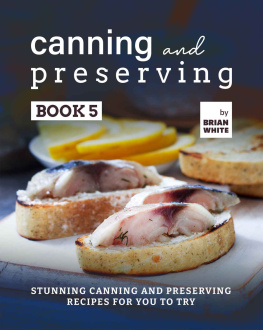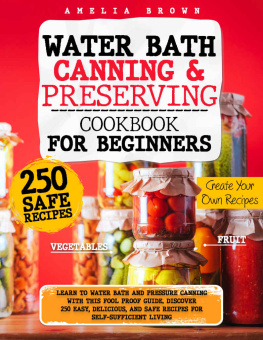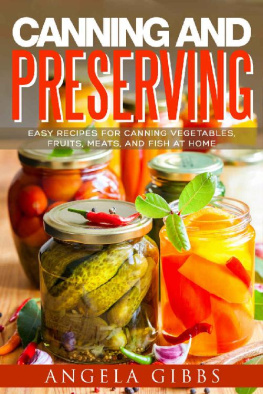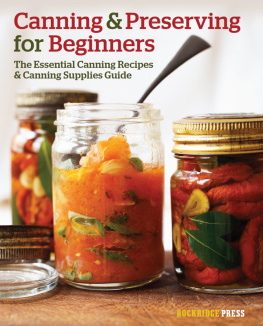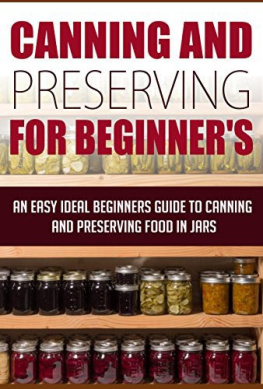Water Bath Canning & Preserving Cookbook for Beginners
A Step-by-Step Guide with Easy to Make and Store Recipes
to Fill Your Pantry and
Create your 1000 Days Survival Food Storage.
Flora Allen
Copyright 2022 by Flora Allen - All rights reserved .
This document is geared towards providing exact and reliable information in regard to the topic and issue covered.
- From a Declaration of Principles which was accepted and approved equally by a Committee of the American Bar Association and a Committee of Publishers and Associations.
In no way is it legal to reproduce, duplicate, or transmit any part of this document in either electronic means or in printed format. All rights reserved.
The information provided herein is stated to be truthful and consistent, in that any liability, in terms of inattention or otherwise, by any usage or abuse of any policies, processes, or directions contained within is the solitary and utter responsibility of the recipient reader.
Under no circumstances will any legal responsibility or blame be held against the publisher for any reparation, damages, or monetary loss due to the information herein, either directly or indirectly.
Respective authors own all copyrights not held by the publisher.
The information herein is offered for informational purposes solely and is universal as so. The presentation of the information is without contract or any type of guarantee assurance.
The trademarks that are used are without any consent, and the publication of the trademark is without permission or backing by the trademark owner. All trademarks and brands within this book are for clarifying purposes only and are owned by the owners themselves, not affiliated with this document
Please note the information contained within this document is for educational and entertainment purposes only. All effort has been executed to present accurate, up to date, and reliable, complete information. No warranties of any kind are declared or implied. Readers acknowledge that the author is not engaging in the rendering of legal, financial, medical or professional advice
In this document you will find recipes that you can repeat for 1000 days
Table of Content
INTRODUCTION
Proper food storage will help you preserve the nutritional value and quality of your items and help you maximize your food budget by preventing food spoilage. Proper food storage can help prevent foodborne diseases caused by pathogenic bacteria.
There are many options available for food preservation. To extend the shelf life of food at your home or business, you can use cooling, freezing, canning, and sugaring, canning, canning, canning, salting, and vacuum packaging. Food preservation specialists are constantly looking for new ways to expand our options.
Canning is one of the most efficient and convenient ways to preserve food. Canning involves preserving food in sealed containers. The temperature at which the food is heated to kill microorganisms that cause food spoilage is achieved by placing it in jars. The heat causes air to escape from the pot, and the jar will cool down, creating a vacuum. The vacuum seal stops air from entering the product, contaminating it with microorganisms. Two basic but very effective methods are available for canning.
- Water-bath treatment and.
- Canning under pressure
This book will teach you how to water-bath canning.
Water-bath canning is also known as "boiling water bath" and is the easiest method to preserve homemade jams, pickles, and tomato sauce. The fresh flavor of the jars can be preserved for up to one year by boiling them in water after they have been prepared. You can preserve the jars for up to one year by boiling the prepared food for 10 minutes after the process is complete.
Water-Bath Canning can also be called "Hot Water Canning" and "Boiling Water Bath." It is one of the two home-canning methods (the other being pressure canning).
Why Does Water-Bath Canning Exist?
The summer and fall are bursting with fruit and vegetables at farmer's markets and gardens. Water-Bath Canning can be a cost-effective way to preserve fresh food all year.
Only acid-RICH vegetables are suitable for water-bath canning. We will discuss tomatoes, berries, fruits, sauerkraut, pickled vegetables, and fruit. This means that jams, jellies, and pickled vegetables can be preserved using water-bath canning. They can be preserved without high pressure by their intrinsic acidity and time in boiling water. You must take precautions.
To kill harmful bacteria, meats, fish, poultry, chili, beans, and corn must be stored at a higher temperature (240F). Low-acid foods should be preserved under pressure
What Preserving Supplies Do You Require?
You will need some equipment to get started. You can save money somehow, but food safety should be the main focus of all your decisions.
A large, deep aluminum kettle is used to boil water. These kettles have tight-fitting lids and can submerge jars completely, leaving at least 1" above their tops. Flat bases are preferable (to fit all cooktops). A boiling water canner is not required, but any stockpot must work similarly.
It is essential to have a rack that fits in the canner. This will keep the jars above the heat from the stockpot's bottom. Avoid putting pots on the bottom of the canner as the heat will damage them.
You can find limited- and broad-mouth options for four-ounce, half-pint, pint, and quart canning containers in wide-mouth and narrow-mouth sizes. Jars from the Kerr, Ball, and Mason brands are most commonly used. Pots can be reused. You can reuse your jars in many ways, including glass storage jars made from repurposed pickle and mustard jars or old-fashioned canning containers with wire bails and glass lids sealed using jar rubbers.
You can use clean, rust-free, and unbent metal bands to match your jars. These are threaded onto the threaded edges of the jars and secured the lids until goods are processed. Seal the jars and keep them refrigerated. You can reuse the bands if they aren't damaged or dented.
Single-use metal canning lids that fit your jars. Always use new covers when preparing food. These lids have an inner gasket that softens when you heat the canner to make the food safe. This allows air to escape from the jars while they chill and seals them once the jars cool.
A canning funnel. This funnel is made from stainless steel or plastic and prevents food from getting onto the jar's rim as it fills.
A stainless-steel ladle. A soup ladle is a good choice for filling canning containers. However, if you are looking for a new one, look for one with a more extended handle and a pouring spout.
A jar lifter. These tongs are designed to fit around canning jar rings to hold hot jars in place after processing.
A food processor or strainer. These machines can be of various sizes and designs. They are used to make soft and cooked meals and remove seeds and skins. The Foley Food Mill, which I inherited from my mother, is still used. However, I have a new, heavy-duty food processor attached to my countertop. It comes with different screens and can be used for various purposes. It is too time-consuming to construct and clean during harvesting, preserving, and gardening during the summer rush. Foley, a worn-out piece of furniture, hangs on a hook, ready to go. Although some muscle force may be required, it is reliable and easy to clean.
A stainless steel stockpot is large enough for many tomatoes, berries, or other products to be cooked before being poured into canner jars.
Utilize Appropriate Cooking Surface
Water-bath canning can be done on either an electric or gas stove. Despite what you might have heard, it is unsafe to can in an oven or microwave. You can also make tomatoes and other fruits safe by sterilizing jars and lids. This involves boiling the containers in water, filling them with hot food, and then sealing them with a screw band and lid. Although the jars seal well, they do not retain their seal. However, the contents of the jars have not been heated enough to stop the growth of bacteria, yeast, and toxins when kept at room temperature.








